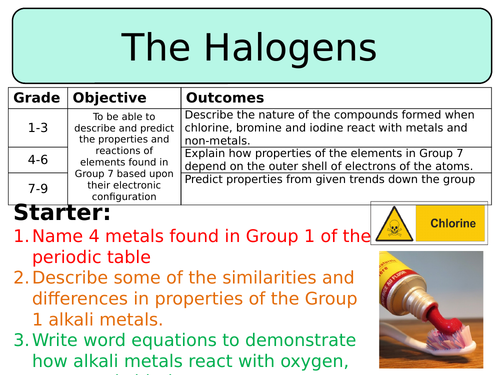
This lesson is designed for the NEW AQA Chemistry GCSE, particularly the 'Atomic Structure & Periodic Table' SoW.
For more lessons designed to meet specification points for the NEW AQA Trilogy specifications for Biology, Chemistry and Physics please see my shop: https://www.tes.com/teaching-resources/shop/SWiftScience
This lesson starts with a diagram of the electronic configuration of fluorine, chlorine and bromine and pupils need to think > pair > share their ideas about any trends/patterns they can see as they go down the group. The trend in the electronic configuration and what this means in terms of reactivity is then outline on the next slide, pupils are then asked to answer questions about this. The answers to which will be revealed so pupils can check their answers.
To summarise what they have learnt so far pupils can complete a fill-in-the-blank task, then they will watch a video which will identify some of the properties of the different elements found in the halogen group.
Once this work has been self-assessed pupils will then be shown what a displacement reaction is and will be given a worked example to demonstrate how it works. Once you feel confident that pupils have understood when a displacement reaction will take place they can complete some word equations to show the products of such reactions. This can then be marked and any misconceptions addressed.
The plenary task is a true or false task which you could conduct as a class or ask pupils to complete in their books and then mark.
All resources are included at the end of the presentation. Thanks for looking, if you have any questions please let me know in the comments section and any feedback would be appreciated :)
For more lessons designed to meet specification points for the NEW AQA Trilogy specifications for Biology, Chemistry and Physics please see my shop: https://www.tes.com/teaching-resources/shop/SWiftScience
This lesson starts with a diagram of the electronic configuration of fluorine, chlorine and bromine and pupils need to think > pair > share their ideas about any trends/patterns they can see as they go down the group. The trend in the electronic configuration and what this means in terms of reactivity is then outline on the next slide, pupils are then asked to answer questions about this. The answers to which will be revealed so pupils can check their answers.
To summarise what they have learnt so far pupils can complete a fill-in-the-blank task, then they will watch a video which will identify some of the properties of the different elements found in the halogen group.
Once this work has been self-assessed pupils will then be shown what a displacement reaction is and will be given a worked example to demonstrate how it works. Once you feel confident that pupils have understood when a displacement reaction will take place they can complete some word equations to show the products of such reactions. This can then be marked and any misconceptions addressed.
The plenary task is a true or false task which you could conduct as a class or ask pupils to complete in their books and then mark.
All resources are included at the end of the presentation. Thanks for looking, if you have any questions please let me know in the comments section and any feedback would be appreciated :)
Get this resource as part of a bundle and save up to 50%
A bundle is a package of resources grouped together to teach a particular topic, or a series of lessons, in one place.
Something went wrong, please try again later.
Report this resourceto let us know if it violates our terms and conditions.
Our customer service team will review your report and will be in touch.
£3.00
